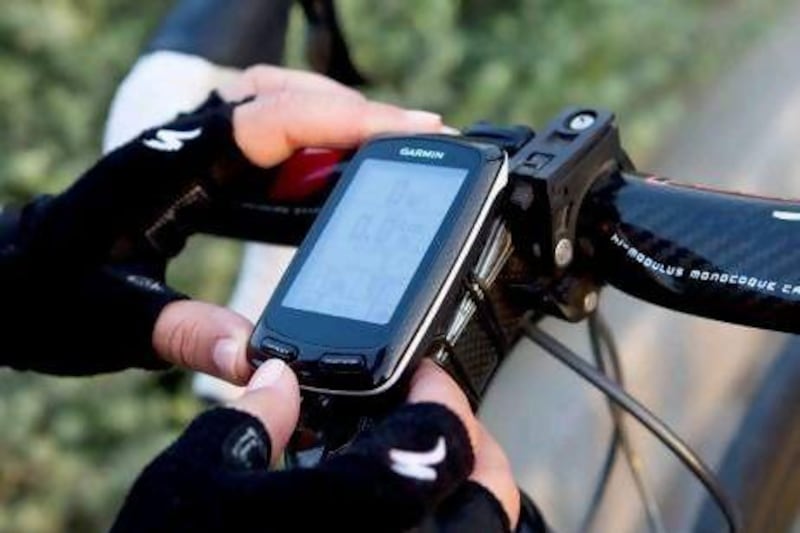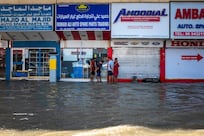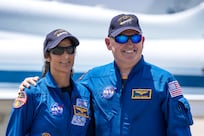When Duncan Clarke wheels his racing bike up to the Yas Marina Circuit at 6pm for his regular Tuesday evening cycle, he’s there to compete for time against more than 500 other riders. But a casual observer would never think that; there are only a few other cyclists on the track with him.
Clarke’s competition also includes several earlier versions of himself – one of the quirks of the new generation of sports-tracking software changing the face of exercising in the UAE. Combining GPS technology with online social media, this new method of training allows virtual races against everyone who has ever ridden the same route.
By the end of the evening, Clarke has completed more than 16 laps of the 5.5-kilometre circuit at an average speed of more than 40 kilometres per hour, but the enervating effect of the heat and humidity have put him more than 30 seconds slower for his best lap compared with the May 22 version of himself.
But it’s still fast enough to claim the best time that day of those using Strava, the GPS-based training software favoured by serious cyclists. And his May 22 time – a lap of seven minutes, 26 seconds, at an average speed of 43.5kph – has still never been beaten by any other Strava user.
“For me it’s really interesting to track my training,” Clarke explains.
“When we first started riding here, you’d be on your own. Some riders’ times would be recorded on the Abu Dhabi tri[athletes] site, but when Strava was introduced, it was obviously a better platform and they started using that.”
That’s a story being repeated across the UAE and around the world as increasing numbers of serious and recreational fitness fans realise the benefits of online training software.
Programmes like Strava – and there are more than half a dozen popular ones, with more basic versions available for free – go much further than just calibrating effort.
Do you need a cycle training route in Dubai that mostly avoids traffic? Check one of more than 400 routes recorded in the city on MapMyFitness. Want an in-line skating circuit in Abu Dhabi that avoids crossing a road? Log into Endomondo; this site will also find you jogging routes, measure effort in the equivalent number of hamburgers offset or percentage of the distance to the moon, as well as give you kayaking routes in Dubai. Such lists go on and on.
One of Strava’s most enthusiastic recent devotees is Dubai cyclist Michael Sagermann, who says the information-sharing facility makes it the “Facebook or Twitter for cycling”.
“You can share as much information as you want and you can set it if you don’t want other people to see how you’re training – even some of your teammates who you’re hypercompetitive with,” he says.
“You have a mechanism to measure your performance … whether it’s against yourself or other people. You can compare what you’ve done in the past and what the benchmark is. You can see your wattage, speed, cadence and heart rate – it’s pretty reasonable data analysis.”
The ability to compare can be a powerful motivator. On Tuesday this week, Sagermann was doing one of the standard Dubai road routes, a 7.4km loop at Nad Al Sheba.
On Strava’s records, the route has been done 644 times, involving 37 different cyclists, and Sagermann, at 8m15s, has the fastest time – KOM, or King of the Mountain, in Stravaspeak – at a blistering average pace of 53.5kph.
In May, less than a week after Sagermann set the fastest pace, another cyclist tackled exactly the same route and was an agonisingly close one second slower. It’s that kind of virtual matchup (such races are not held head-to-head) which helps motivate people to push their limits.
Sagermann’s heart rate for that peaked at a hectic 171 beats per minute. Its use of that kind of data gathered by programmes like Strava that take such programmes far beyond creating a high-tech version of the humble stopwatch.
Through a combination of the GPS and a heart-rate monitor, Strava is able to keep track of everything from maximum power put through the pedals (a maximum of 671watts, in Sagermann’s case, or enough to simultaneously power four 80cm televisions), maximum heart rates, cadence and median speeds.
Another reason Strava is favoured is it also offers – as part of its paid-for premium package – what it aptly calls the “suffer score” – an overall number which is based on a mix of data that is weighted towards the amount of time spent near to the maximum heartbeat.
That’s become a source of perverse pride to see who can quantify the most suffering. And, in its own way, it levels the playing field between professionals and amateurs because it measures the amount of effort being applied rather than outright speed.
The ability to accurately compare performances comes at its own cost, particularly with the emphasis on accruing as many KOMs as possible.
It’s even led to tragedy in some cases. Strava is being sued in the United States over the death of a Strava user who collided with a car while trying to regain his KOM title on a public road in Berkeley, California. The cyclist’s family claims Strava’s KOM feature contributed to the fatality.
That focus on KOMs is one Clarke recognises as a double-edged sword.
“It’s interesting. Depending on your personality, it could be motivating for people so they know they can go hard. But I think some guys get stuck on that and they go out trying to get Strava records instead of training properly. They get distracting by driving hard every night.”
Sagermann concurs, describing the focus on KOMs as sometimes counterproductive.
“You can’t go flat out all the time – you work in waves, training for a particular event, and don’t want to peak too early,” he adds.
“You can get a little bit addicted to KOM tags. Sometimes it’s ego related. I fell into that a little bit – you’d study who is KOM and send a message that you’re stronger.
“Strava is enormously effective in gauging your training effectiveness but you have to not get involved in foolishness.”
There’s even a term coined for the syndrome – Stravacide. Competitive Cyclist website, while eulogising the programme, also defined Stravacide as: “To ride significantly harder during training than originally planned (such as on a climb or a defined stretch of road) in order to increase one’s ranking on the Strava Leaderboard for a specific segment.”
For the average user of such programmes, whose interest is just to keep fit rather than to break any records or claim KOM crowns, there is still plenty of interest.
Aubrey Roberts, a Welsh cyclist living in Abu Dhabi, said he and his cycling buddies use Endomondo as a way to ensuring they are putting in the training hours, even if they are doing it solo.
Twelve of them are heading to the Pyrenees this week to do the Raid Pyreneen, a designated 760km cycle route that crosses 18 passes in the mountains separating France and Spain. The goal is to complete the route, including 10,000 metres of elevation, within 100 hours.
“I’ve only had the GPS since Christmas and a few of the lads here are using Endomondo. Whoever’s done the most kilometres [before we go to the Pyrenees] wins a small wager,” he said.
“I recently did my 100th ride this year, which is a total of about 7,500km.”
He was at Yas Marina Circuit adding to his mileage tally before the trip but said Endomondo would be equally helpful when he was on the Raid Pyreneen.
“You can time yourself against people on the passes. You can track yourself against everyone who tracks it with Endomondo. You get to track yourself.”
However he said there were also unusual downsides to such sports tracking programmes, which in Britain are being exploited by criminals.
“People will trace your ride to your house and break into your garage [to steal your bike] or they’ll see when you’re normally out cycling and burgle your house,” he said.
Most of the programmes have adapted to overcome that weakness. Strava, for example, offers an option to scramble the GPS track for the first 2km to disguise the location of your house.
But there are also non-malicious but equally unexpected uses of the technology, such as James Bishop’s decision to spend five hours jogging through central Paris along a 29.8km route that, when overlaid on a map, depicted the shape of the Endomondo logo.
For the final analysis, the appeal of these programmes comes down to a few simple but important factors. It’s neatly summarised by Tareq Ansari, an Endomondo user who was at Yas Marina Circuit last week and was doing laps at a far more modest pace than those set by the likes of Clarke. But that was fine by him.
“You can get in touch with your friends and compare against each other,” he says.
“It’s easy to see your rate of progress as you get better and it motivates you to get better.”






